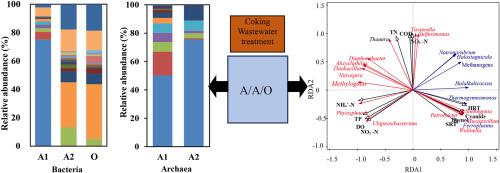Chemosphere ( IF 8.1 ) Pub Date : 2021-08-03 , DOI: 10.1016/j.chemosphere.2021.131724 Qiaoying Ban 1 , Liguo Zhang 1 , Jianzheng Li 2

|
Coking wastewater (CWW) contains various complex pollutants, and biological treatment processes are frequently applied in the coking wastewater treatment plants (CWWTPs). The present work is to evaluate the contaminants removal of a full-scale CWWTP with an anaerobic-anoxic-oxic process (A/A/O), to reveal function of bacterial and archaeal community involved in different bioreactors, and to clarify the relationship between the performance and microbial community. Illumina Miseq sequencing of bacteria showed that β-proteobacteria dominated in three bioreactors with relative abundance of 60.2 %∼81.7 %. 75.2 % of sequences were assigned to Petrobacter in the bioreactor A1, while Thiobacillus dominated in A2 and O with relative abundance of 31.8 % and 38.7 %, respectively. Illumina Miseq sequencing of archaea revealed a high diversity of methanogens existed in A1 and A2 activated sludge. Moreover, Halostagnicola was the dominant archaea in A1 and A2 activated sludge with relative abundance of 41.8 % and 66.5 %, respectively. Function predicted analysis explored that function of bacteria was similar to that of archaea but the relative abundance differed from each other. A putative biodegradation model of CWW treatment in A/A/O process indicated that A1 and A2 activated sludge mainly reduced carbohydrate, protein, TN, phenol and cyanide, as well as methane production. Bacteria in the bioreactor O were responsible for aerobic biotransformation of residual carbohydrates, refractory organics and nitrification. The redundancy analysis (RDA) further revealed that removal of COD, TN, and NO3−-N, phenol and cyanides were highly correlated with some anaerobic bacteria and archaea, whereas the transformation of NH4+-N was positively correlated with some aerobic bacteria.
中文翻译:

煤炭工业中采用厌氧-缺氧-好氧工艺的焦化废水处理厂的细菌和古菌群落与效率的相关性
焦化废水(CWW)含有多种复杂的污染物,焦化废水处理厂(CWWTPs)经常采用生物处理工艺。目前的工作是评估具有厌氧-缺氧-好氧过程 (A/A/O) 的全规模 CWWTP 的污染物去除,揭示不同生物反应器中细菌和古菌群落的功能,并阐明两者之间的关系。性能和微生物群落。Illumina公司Miseq细菌的测序表明,β -变形菌三种生物反应器与60.2%~81.7%相对丰度为主。生物反应器 A1 中75.2% 的序列属于石油杆菌属,而硫杆菌属在 A2 和 O 中占主导地位,相对丰度分别为 31.8% 和 38.7%。Illumina Miseq 古细菌测序显示 A1 和 A2 活性污泥中存在高度多样性的产甲烷菌。此外,Halostagnicola是 A1 和 A2 活性污泥中的优势古菌,相对丰度分别为 41.8% 和 66.5%。功能预测分析探讨了细菌的功能与古细菌的功能相似,但相对丰度彼此不同。A/A/O 工艺中 CWW 处理的假定生物降解模型表明,A1 和 A2 活性污泥主要减少碳水化合物、蛋白质、TN、苯酚和氰化物,以及甲烷的产生。生物反应器 O 中的细菌负责残留碳水化合物、难降解有机物和硝化作用的有氧生物转化。冗余分析(RDA)进一步揭示了COD、TN、NO 3 - -N、苯酚和氰化物的去除与一些厌氧菌和古菌高度相关,而NH的转化4 + -N 与一些需氧菌呈正相关。











































 京公网安备 11010802027423号
京公网安备 11010802027423号